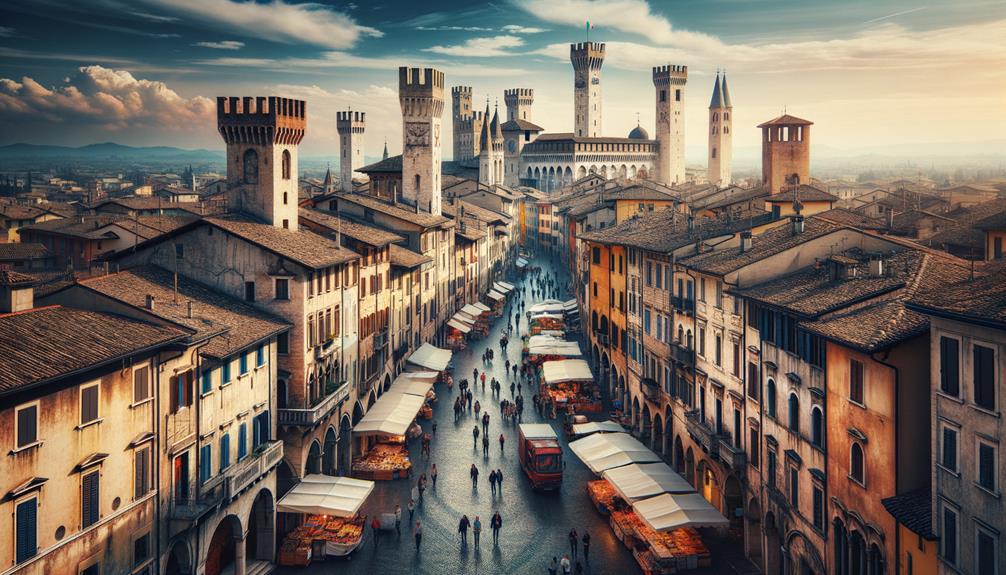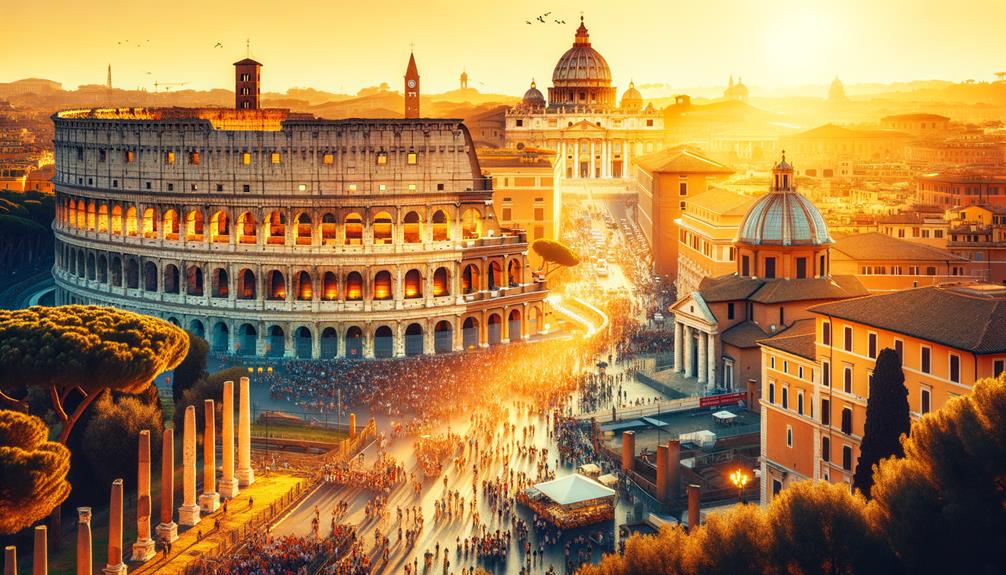As I strolled through Bologna's historic center, I felt wrapped up in its rich history and culture. The grand Piazza Maggiore, with its striking Palazzo Comunale and the timeless charm of Palazzo Re Enzo, grabbed my attention right away. The Basilica of San Petronio stood tall, hinting at the tales held within its walls. Climbing the Tower of Asinelli offered unbeatable views of the city's famous red rooftops. But it was the endless porticos, stretching over the streets like protective arms, that truly captivated me. What stories do these ancient walkways hold?
Popular Landmarks
Wandering through Bologna's historic center, I was immediately struck by its landmarks, each echoing the city's rich history. Stepping into Piazza Maggiore, the heart of the historic area, I felt surrounded by centuries of stories. With the majestic Palazzo Comunale and Palazzo Re Enzo on either side, this square is a lively hub of local life and stunning architecture.
The Basilica of San Petronio, one of the world's largest churches, caught my eye next. Its unfinished facade hints at the ambitious plans of its creators, while the vast interior speaks volumes about its historical and religious importance.
A short walk brought me to the Fountain of Neptune in Piazza del Nettuno. This impressive statue once symbolized the Pope's power in the 16th century, and its grandeur still commands attention today.
Climbing the 498 steps of the Tower of Asinelli was tough, but the panoramic views of Bologna's red rooftops made it all worthwhile. Lastly, exploring the intricate Basilica di Santo Stefano, with its mix of architectural styles, felt like walking through a living museum. Each landmark in Bologna's historic center offers a glimpse into the city's rich and varied history.
Historic Walking Tours
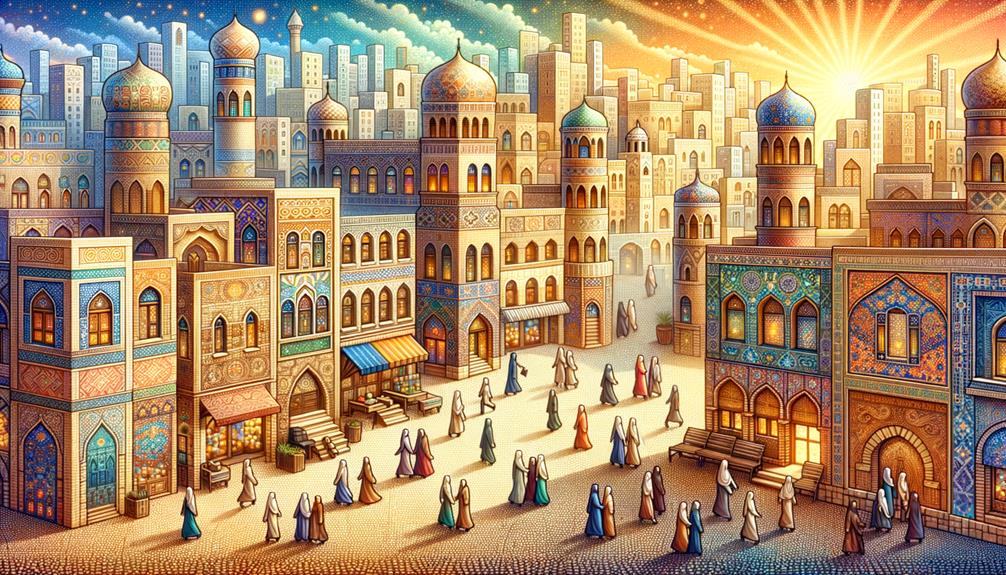
Walking through Bologna's historic center on a guided tour, I felt a strong connection to the city's lively past and present. Each step on the cobblestone streets revealed a new chapter, with medieval towers casting shadows over bustling squares. We started at Porta Galliera, a stunning 13th-century gate that guards the treasures inside.
Strolling along Via Indipendenza, I was swept up by the city's rhythm. The lively pedestrian zones were easy to navigate, allowing me to soak in the sights and sounds. Historic buildings lined the street, each facade telling stories of bygone eras. Street musicians provided a melodic backdrop, their tunes blending with the laughter and chatter from nearby cafes.
As I ventured further into the historic center, Piazza Maggiore came into view, a grand stage where Bologna's history unfolds. This iconic square, surrounded by remarkable architecture, felt like the heart of the city. Wandering through the piazza, the blend of past and present was evident, creating a unique atmosphere in this UNESCO World Heritage Site.
In Bologna, every walk feels like a journey through time.
Iconic Porticos
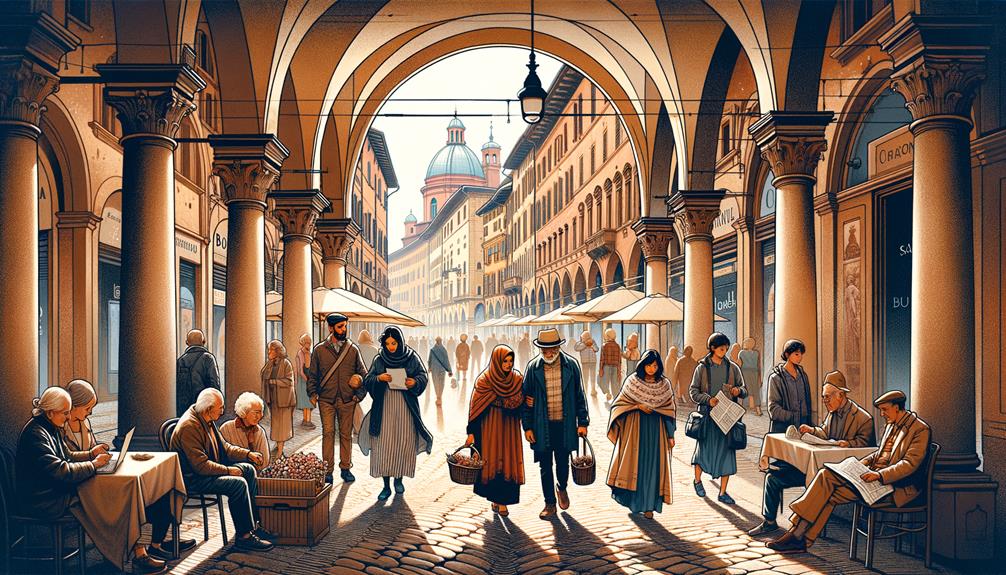
Walking beneath the porticos of Bologna, I couldn't help but admire their beauty and the sense of history they carry. Stretching over 38 kilometers, these arcades form one of the longest covered walkways in the world, a UNESCO World Heritage Site that showcases Bologna's unique charm.
As I walked through the Portico of San Luca, the sheer scale of it left me in awe. This 3.5-kilometer-long portico, with its 666 arches, connects the city center to the Sanctuary of San Luca. The path offers incredible views of Bologna, making each step worth it.
The medieval Portico dei Banchi caught my attention with its detailed frescoes and decorations. This portico is a testament to Bologna's rich cultural heritage, a beautiful reminder of the city's history. I often found myself stopping to take in the artistry around me.
When I reached the Portico of Pavaglione, I was struck by its Renaissance elegance. With 46 arches, this portico is lined with high-end boutiques and cafes, blending history with modern luxury. No matter where I wandered, the porticos offered shade and protection, a comforting presence in any weather. The porticos of Bologna are more than just architectural feats; they are a vital part of the city's character.
Stadio Bologna Highlights
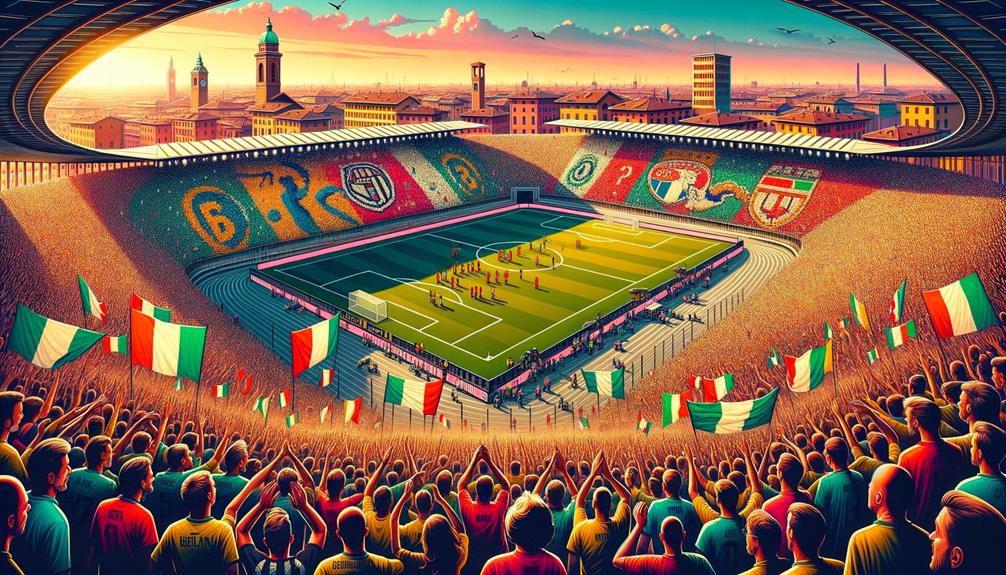
As I walked up to Stadio Renato Dall'Ara, the blend of its historic architecture and the buzzing atmosphere around it immediately drew me in. Located in the lively city of Bologna, this stadium uniquely combines history with modern touches. Built in 1927, it's a testament to Bologna's rich sporting heritage. Major renovations in 1990 improved its facilities and increased its seating capacity to 38,279 spectators.
Strolling around the stadium, I thought about the many football matches and victories that have taken place here. As the home ground for Bologna F.C. 1909, the stadium is filled with the energy of Serie A football. It also occasionally hosts the Italy national football team, adding to its prestige. The grass surface shines under the sunlight, ready for the next exciting game.
But it's not just about football here. The stadium also hosts concerts and rugby matches, making it a focal point of activity in the city. As a UEFA category 4 stadium, it's equipped to host international competitions, highlighting its significance in Bologna's cultural and sporting life.
Countryside Excursions
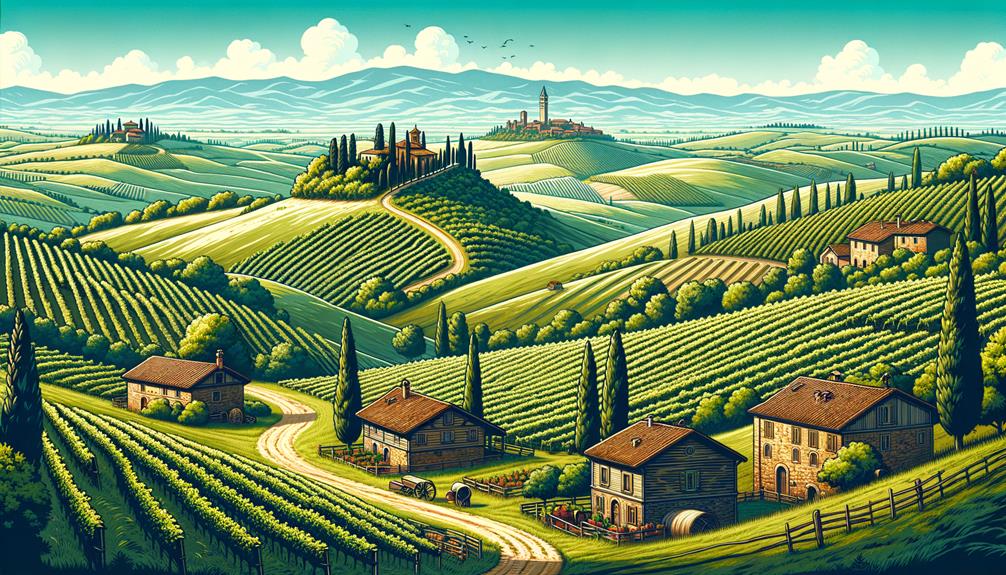
When I wandered through the Bologna hills, I was struck by the beautiful vineyards and charming wineries, each offering a taste of the area's rich winemaking tradition. The historic villas and estates scattered across the countryside added a magical feel, letting me imagine life in an earlier time. These countryside trips were a perfect match for the urban appeal of Bologna's historic center.
Scenic Vineyards and Wineries
Tucked away in the rolling hills just outside Bologna, the Colli Bolognesi wine region offers a charming escape with its picturesque vineyards and family-run wineries. These vineyards cover over 4,000 hectares, creating a stunning landscape that's perfect for anyone looking for some peace and quiet. As I strolled through these historic lands, I felt a deep connection to centuries of wine-making tradition. The region is famous for its Pignoletto, Trebbiano, and Sangiovese wines, each bottle reflecting the soil and the hands that crafted it.
The Bologna Wine Route, or Strada dei Vini, drew me in with its 130-kilometer journey through the countryside, linking passionate wine producers and inviting vineyards. Each stop along the route offered a unique insight into the art of wine-making, guided by families who have honed their craft over generations. The Consorzio Vini Colli Bolognesi ensures that every wine I tasted was of the highest quality and authenticity.
Reflecting on this experience, I realized that the true essence of Colli Bolognesi lies in its mix of natural beauty and historic wine-making heritage, making it a perfect retreat for those wanting to explore and enjoy life.
Historic Villas and Estates
Wandering through the historic villas and estates in the Bologna countryside, I was struck by their timeless beauty and rich architectural heritage. Each villa, like Villa Edelmetti and Villa delle Rose, offered a unique window into the past, with their Renaissance and Baroque styles telling stories of the eras they were built in. Ornate gardens, frescoed ceilings, and impressive art collections filled these spaces, creating an atmosphere that felt both grand and intimate.
Guided tours really brought these estates to life, often including wine tastings and cooking classes that highlighted local culture and traditions. Standing in the palazzo of Villa Ghigi, I was amazed at the grandeur that marked the lives of its former residents. The countryside around Bologna, with its ancient castles like the Castle of Torrechiara and the Castle of Rossena, added a sense of mystique, offering breathtaking views of rolling hills and serene valleys.
Some villas have been turned into luxury hotels and agriturismos, allowing visitors to soak in the charm and elegance of rural Bologna. Staying in these historic estates provided the perfect escape, a chance to experience the region's history and beauty firsthand, far from the city's hustle and bustle.
Bolognese Cuisine
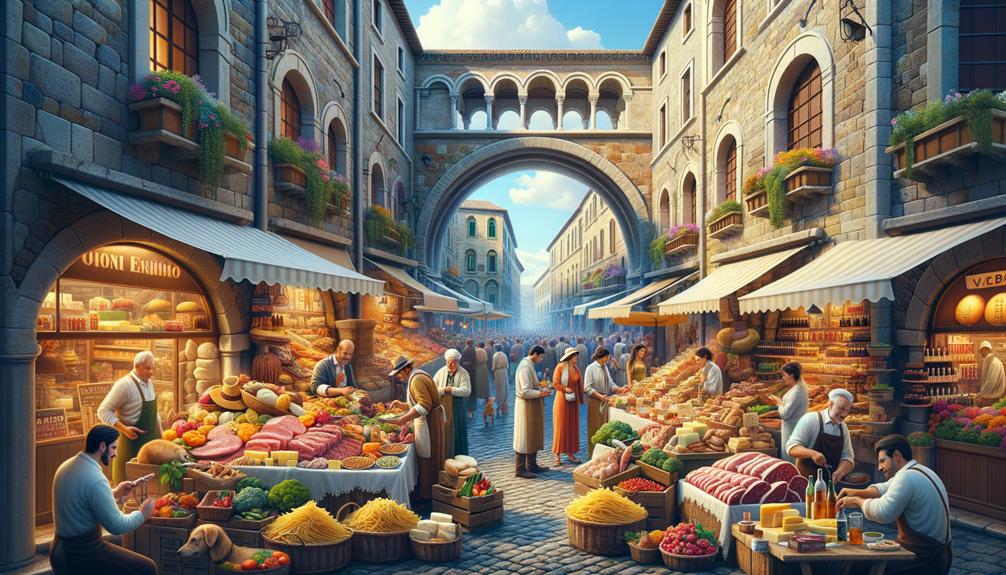
Strolling through Bologna's historic center, the scents of traditional pasta dishes like tagliatelle and tortellini wafted through the air, each bite a nod to the city's rich culinary roots. Wandering around the lively Quadrilatero market, I was amazed by the variety of local cheeses, cured meats, and fresh pasta on offer. The energetic food festivals, celebrating everything from ragù to mortadella, brought the community together in a joyful celebration of flavors.
Traditional Pasta Varieties
Bologna's traditional pasta varieties, like tagliatelle, tortellini, and lasagna, highlight the city's commitment to rich, flavorful, and carefully prepared dishes. Walking through the historic center, with the impressive Palazzo D'Accursio in the background, you can almost taste the essence of Bolognese cuisine in the air.
Tagliatelle, those delicate ribbons of handmade egg pasta, are often paired with the hearty ragù alla bolognese. This sauce, simmered to perfection with ground meat, tomatoes, and onions, is a true culinary masterpiece passed down through generations.
Tortellini, those charming little pasta rings filled with meat or cheese, are often served in a comforting broth or creamy sauce. Every bite tells a story of tradition and a love for the craft.
Lasagna, with its layers of wide flat noodles, meat sauce, and cheese, is a beloved icon of Bolognese cuisine. It's the ultimate comfort food, embodying the warmth and richness of Bologna's culinary heritage.
Think about these:
- The aroma of ragù simmering gently.
- The delicate folds of hand-rolled tortellini.
- The golden, bubbling top of a freshly baked lasagna.
Bologna's pasta varieties are more than just food—they're a celebration of life, history, and freedom.
Local Market Highlights
Strolling through Bologna's historic center, I savored the rich heritage of its pasta dishes. My senses were immediately drawn to the lively Quadrilatero market, the true heart of Bolognese cuisine. The market buzzed with energy, and the air was filled with the mouthwatering aromas of prosciutto di Parma, mortadella, and Parmigiano-Reggiano cheese. Each stall was brimming with flavors, urging me to indulge in the region's culinary treasures.
I couldn't resist stopping at Pasticceria Gamberini, a beloved local spot, for a morning coffee and pastry. The display was a visual delight, showcasing an array of sweets and savories that mirrored Bologna's rich culinary heritage. The delicate pastries melted in my mouth, leaving me wanting more.
As I wandered further, I found vendors selling fresh, handmade egg pasta—a staple of Bolognese cuisine. The vibrant colors and varied shapes of the pasta reflected the craftsmanship and tradition behind each dish. Whether it was tortellini or tagliatelle, each bite told a story of generations past, making my journey through Bologna's food scene truly unforgettable.
Iconic Food Festivals
Amid the lively culture of Bologna, the city's food festivals highlight its deep culinary traditions. Strolling through the historic streets, the enticing aromas from various stalls and eateries pull me in, each offering a unique taste of Emilia Romagna's rich heritage.
Bologna's food festivals aren't just events; they're a celebration of life, flavor, and community. Here are three experiences that made a lasting impression on my culinary journey:
- MortadellaBo: This festival is all about mortadella, Bologna's famous sausage. The city's squares turn into a gourmet haven, where you can enjoy this delicacy in many forms, paired with excellent local wines.
- Il Tortellino: Dedicated to the beloved tortellino, this festival allows you to watch master chefs in action, rolling out pasta and creating these tiny pockets of joy filled with rich, savory meats and cheeses.
- Autunno Bolognese: Celebrating the harvest season, this festival features seasonal produce, hearty dishes, and a selection of Emilia Romagna's finest wines.
Each festival is a vibrant mix of flavors, showcasing Bologna's deep love for food and wine. As I dive into the festivities, I feel a strong connection to the city's heart and soul.
Cultural Hotspots

Exploring Bologna's historic center is like stepping into a rich tapestry of history, art, and architecture. One of my favorite starting points is Piazza del Nettuno. This lively square, home to the impressive Fountain of Neptune, gives you a real sense of the city's vibrant life. Even though the fountain is currently being restored, there's still plenty to admire with the surrounding buildings and bustling cafés.
Just a short walk away, you'll find the Basilica of San Petronio, standing tall and majestic. Inside, the richly decorated side chapels and stunning stained-glass windows create a serene atmosphere. It's fascinating to think about the centuries of history and devotion encapsulated within its walls.
Another gem in the heart of Bologna is the Palazzo d'Accursio, a medieval marvel that now serves as the town hall. Its clock tower and spacious courtyard make you reflect on the passage of time and the layers of history embedded in its stones.
Nearby, the Palazzo Re Enzo with its beautiful central courtyard and grand stairways offers a quiet respite. Meanwhile, the Biblioteca Salaborsa provides a peaceful haven for book lovers, housed in a medieval building brimming with community spirit.
Architectural Marvels
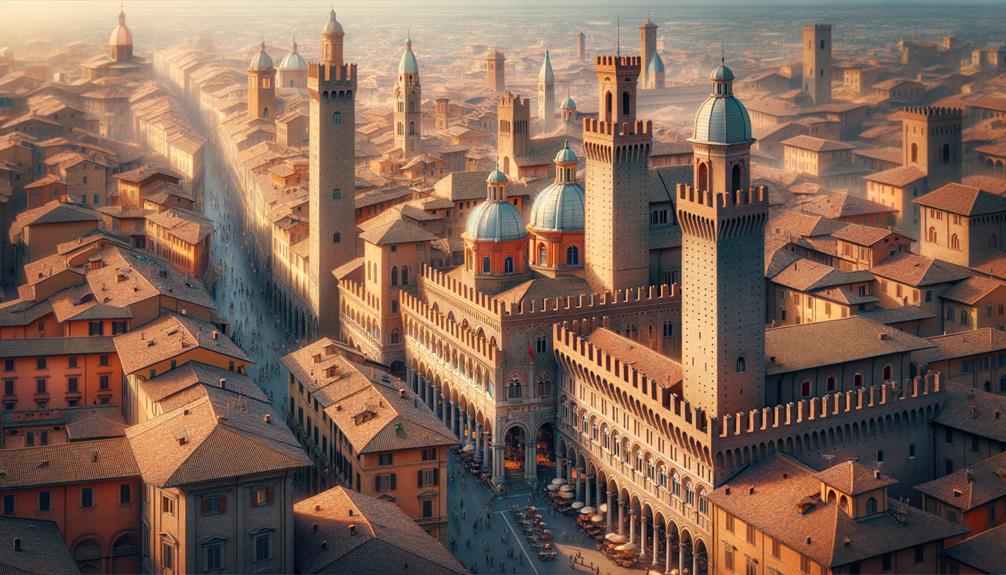
Strolling through Bologna's historic center, I can't help but be amazed by the medieval towers that stand tall against the skyline, each one narrating a piece of the city's history. The endless porticoes and arches not only provide shade but also offer a sense of continuity and connection. It's incredible how these architectural elements have stood the test of time, adding to the city's unique charm and historical depth.
Medieval Towers
The medieval towers of Bologna stand tall, telling stories of power, prestige, and impressive architecture. As I wander through the historic center, the sight of the Two Towers—Asinelli and Garisenda—grabs my attention. These landmarks dominate the skyline, reflecting the city's rich history and medieval ambitions. The leaning Tower of Garisenda, with its noticeable tilt, especially intrigues me, representing the bold and sometimes flawed architectural attempts of the past.
The Asinelli Tower, standing at 97.2 meters, offers a panoramic view of Bologna for those who climb its 498 steps. Each step feels like a journey back in time, connecting me to the craftsmen who built it.
Thinking about these towers, I feel:
- Awe at Their Heights: Standing beneath these giants, I feel both small and deeply connected to history.
- Admiration for Their Design: Despite their age, their design rivals modern structures in creativity.
- Fascination with Their Stories: Each tower tells tales of medieval life, power struggles, and the quest for immortality.
These towers are more than just buildings; they symbolize human ambition and the relentless pursuit of greatness.
Porticoes and Arches
The porticoes and arches of Bologna create a mesmerizing maze that makes me want to wander deeper into the city's architectural wonders. As I stroll through Bologna's historic center, I'm entranced by these structures that seem to go on forever, providing both shelter and a sense of timelessness. Each archway offers a unique glimpse of the city, from lively markets to quiet, cobblestone streets.
These porticoes aren't just practical; they tell tales from centuries ago. I can almost see medieval merchants and scholars walking the same paths, their footsteps echoing through history. The arches, with their graceful curves, draw my eyes upward, revealing intricate details that are easy to miss. The interplay of light and shadow beneath them feels like a dance, creating a peaceful and thoughtful atmosphere that contrasts with the bustling city center.
In Bologna's historic heart, the porticoes provide both a refuge from the weather and a gateway to new experiences. They embody a spirit of freedom, inviting me to get lost in their winding beauty while connecting me to Bologna's rich history. Every turn under these arches feels like an invitation to dream, explore, and find my own path.
Local Markets
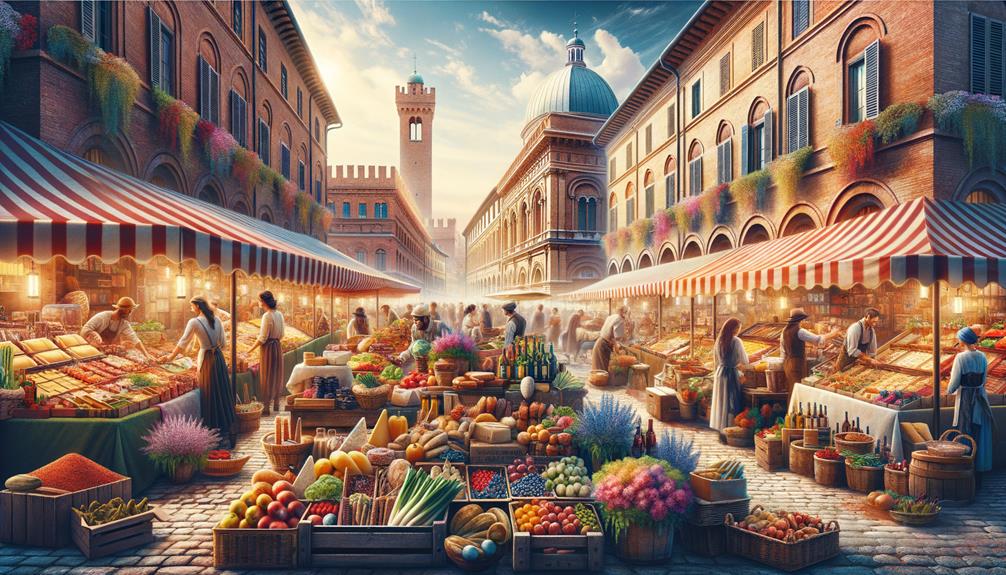
Bologna's local markets are a sensory delight, full of vibrant colors, inviting aromas, and a bustling atmosphere that perfectly embodies the city. After settling into an apartment on Via Indipendenza, I couldn't wait to explore the market scene. What I found was truly enchanting.
As I wandered through the markets, I felt immersed in Bologna's daily life. The stalls were brimming with fresh produce, artisanal cheeses, and fragrant flowers. Each vendor greeted me warmly, their love for their work clear in every interaction. The energy was infectious, and I found myself lost in the sensory experience.
Here are three highlights that really stood out:
- Mercato delle Erbe: This indoor market is a sensory feast with its wide variety of fresh fruits, vegetables, and local delicacies.
- Mercato di Mezzo: Located in the Quadrilatero, this historic market offers a charming mix of traditional and modern culinary treats.
- Mercato Ritrovato: A farmer's market that champions sustainability, featuring organic produce and handmade goods.
Reflecting on my market visits, I realized they were about more than just shopping—they were about connecting with the heart of Bologna and experiencing its vibrant culture firsthand.
Travel Tips
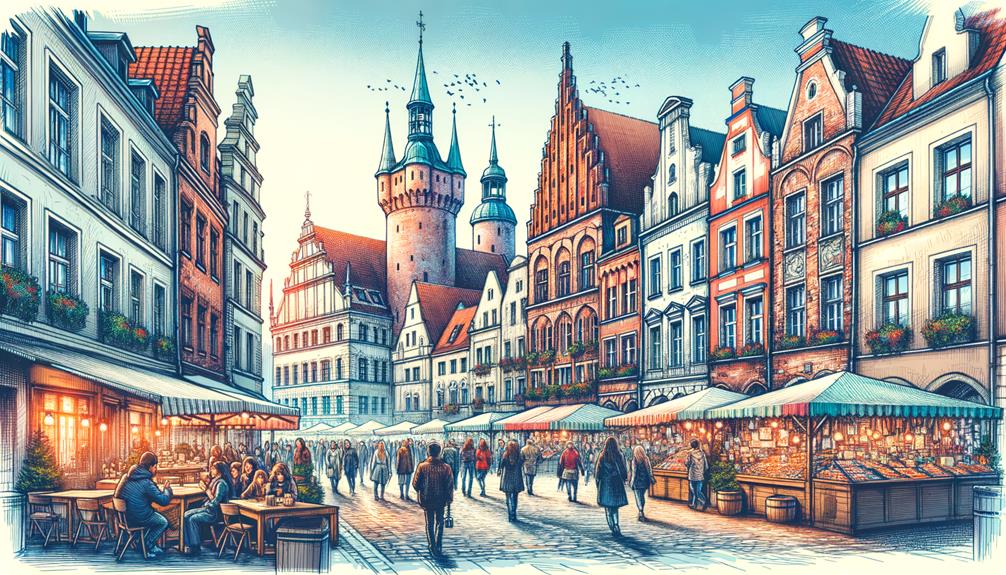
Exploring Bologna's historic center is easy if you keep a few key travel tips in mind. First, wear comfortable shoes. The cobblestone streets are charming but tough on flimsy footwear. Walking around lets you truly soak in the history at every corner, especially when you come across the grandeur of Palazzo Re Enzo. This medieval palace, with its imposing structure, tells tales of ancient power and intrigue.
Timing your visit is also important. Early mornings or late afternoons are perfect for avoiding the crowds. This way, you can really appreciate the serene beauty of Piazza Maggiore or the quiet grace of the University of Bologna, the world's oldest university. I love strolling through its ancient corridors, imagining the countless scholars who once walked these halls.
Bring a map, but also trust your instincts. Bologna's historic center is a maze of delightful surprises. Every twist and turn can lead to an unexpected café or a hidden piazza. Freedom is the essence of travel, and in Bologna, it's all about letting the city reveal itself to you, one step at a time.
Frequently Asked Questions
What Are the Main Attractions in Bologna?
Bologna has some amazing spots that you'll definitely want to check out. I was blown away by the Basilica of San Petronio, Palazzo d'Accursio, Piazza Nettuno, Palazzo Re Enzo, and Biblioteca Salaborsa. Each of these places offers a unique glimpse into the city's rich history.
How Walkable Is Bologna?
Bologna is super walkable. You can easily get around the charming historic center on foot. The city's flat terrain and those famous porticos make it a breeze. The medieval streets and pedestrian zones add to the fun of exploring.
What Is the Main Center in Bologna?
The main hub in Bologna, Piazza Maggiore, is like the city's heartbeat, full of history and culture. Surrounded by medieval buildings and bustling arcades, it perfectly captures Bologna's timeless charm.
What Is the Famous Street in Bologna?
Via Indipendenza is the well-known street in Bologna. I love walking along its upscale shops and cozy restaurants. The historic buildings and covered arcades create a vibrant and timeless atmosphere that really draws me in.

